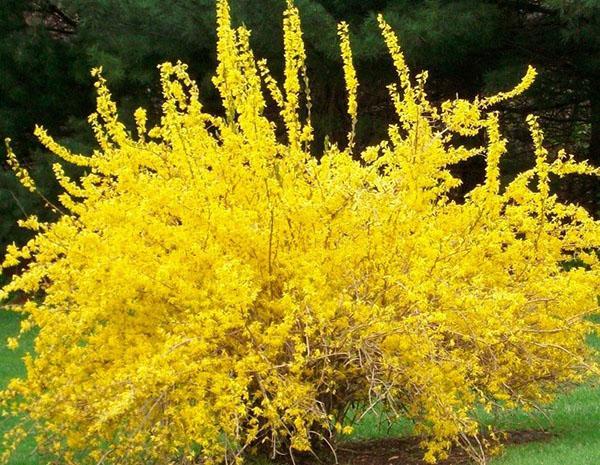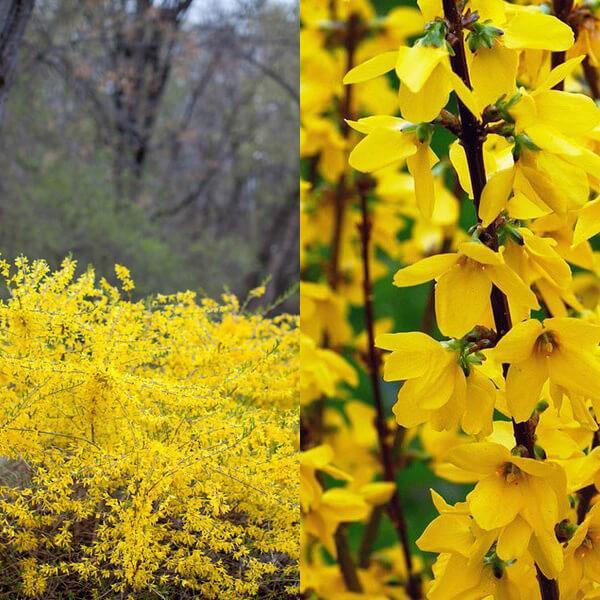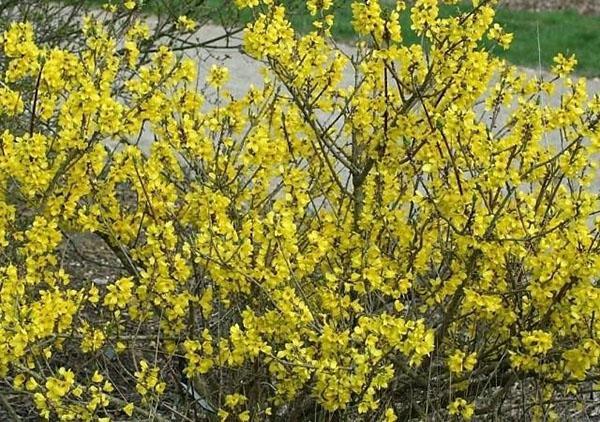Amazing species and varieties of forsythia - a golden-blooming shrub
 In early spring, when many trees are still dormant, the exquisite bush puts on its golden adornment. That is why gardeners grow various types and varieties of forsythia on their backyards. For 200 years, the shrub has been popular with residents of America, Europe, the Far East and Asia. It has been warmly cared for in China for several thousand years now, admiring its amazing beauty of spring decoration.
In early spring, when many trees are still dormant, the exquisite bush puts on its golden adornment. That is why gardeners grow various types and varieties of forsythia on their backyards. For 200 years, the shrub has been popular with residents of America, Europe, the Far East and Asia. It has been warmly cared for in China for several thousand years now, admiring its amazing beauty of spring decoration.
At the end of the 18th century, the Scottish scientist W. Forsyth brought several species and varieties of forsythia from China to Europe. The plant was liked by the inhabitants of cool countries and in gratitude to the scientist, the shrub was named after him. Today, the plant adorns private gardens, city parks, streets and summer cottages for lovers of greenery. Forsythia is considered a unique symbol of spring, which it meets with bright inflorescences. As soon as the yellow lights "light up" on the bushes, summer residents come to life together with nature and get ready for land work.
Close acquaintance with the bush

- bright yellow;
- lemon;
- golden;
- light brown;
- dark orange;
- light green;
- white.
Interestingly, flowering lasts a long period, sometimes about 40 days. It is truly a wonderful sight! Over time, fruits appear on the bush in the form of a pretty box, which stores many winged seeds. But the whole season, flexible shoots of forsythia are strewn with many oval-shaped leaves, the length of which reaches about 15 cm.
Since the shrub is not picky about the type of soil, it is freely grown in the garden plots of country houses. The main thing is to provide him with enough sunlight.
Famous species and varieties of forsythia: description and photo
 Over the years, breeders have diligently bred many varieties of this ornamental plant. Each species has its own characteristics. The bush is characterized by the following differences:
Over the years, breeders have diligently bred many varieties of this ornamental plant. Each species has its own characteristics. The bush is characterized by the following differences:
- the appearance of the crown;
- plant shape;
- the size;
- kind of branches.
Depending on the type of forsythia, the following bud sizes are distinguished:
- miniature;
- medium;
- inflorescences are giants.
Also, the varieties differ in pigmentation:
- sheet plates;
- shoots;
- buds.
Interestingly, the leaves can be colored not only green, but also yellow. Some species are distinguished by the purple color of the leaf plates. Likewise, bush branches are yellow, green, and even red. A detailed description of forsythia helps to become closely acquainted with this bright symbol of the arrival of mother spring on earth. Consider its popular types and varieties.
It was noticed that in winter, when there is a lot of snow, some birds peck up flower buds on the bush. With this in mind, it is advisable to protect the plant from annoying "clients" by taking appropriate measures.
European
 This is the only type of shrub that has been developed in Europe. Only in 1897 did biologists describe it in detail. As you can see in the photo, European forsythia has a compact and neat crown, consisting of straight stems.An adult plant reaches a height of 3 m, which allows it to fit into the general landscape of the garden. In early spring, the shrub is dressed in lemon-yellow floral decoration. The size of the buds can be more than 5 cm in length. Usually, flowering is accompanied by the appearance of greenery on flexible shoots, therefore, the decorativeness of such a large-flowered forsythia is inferior to other types of its congeners.
This is the only type of shrub that has been developed in Europe. Only in 1897 did biologists describe it in detail. As you can see in the photo, European forsythia has a compact and neat crown, consisting of straight stems.An adult plant reaches a height of 3 m, which allows it to fit into the general landscape of the garden. In early spring, the shrub is dressed in lemon-yellow floral decoration. The size of the buds can be more than 5 cm in length. Usually, flowering is accompanied by the appearance of greenery on flexible shoots, therefore, the decorativeness of such a large-flowered forsythia is inferior to other types of its congeners.
Since European forsythia does not always tolerate the winter cold, it is best grown in areas with warmer climates.
Egg-shaped (oval)
 Unlike European forsythia, this species is highly frost-resistant. Even in areas where the temperature drops below -30 °, the plant does without additional shelter. The only drawback of ovoid forsythia is the transience of spring flowering.
Unlike European forsythia, this species is highly frost-resistant. Even in areas where the temperature drops below -30 °, the plant does without additional shelter. The only drawback of ovoid forsythia is the transience of spring flowering.
The shrub grows up to 2 meters high. Thanks to this, it fits wonderfully landscape design of the suburban area. Differs in shoots of a grayish-yellow color, on which green foliage is located. In early spring, single buds appear on oval forsythia, decorating the bush for about 15 days. There are several varieties of this ornamental shrub:
- Tetragold;

- Spring Glory;

- Dresdner Forfrühling;

Each has its own unique characteristics, thanks to which, fans of greenery choose the right option.
Hanging
 An amazing shrub with arched shoots of olive color, actively grown to decorate the walls. Hanging forsythia is considered a symbol of the Korean city of Seoul. Every year there is a massive admiration for the bright flowering of the bush. There are a huge number of varieties of hanging or drooping forsythia, as many call it. Here is some of them:
An amazing shrub with arched shoots of olive color, actively grown to decorate the walls. Hanging forsythia is considered a symbol of the Korean city of Seoul. Every year there is a massive admiration for the bright flowering of the bush. There are a huge number of varieties of hanging or drooping forsythia, as many call it. Here is some of them:
- Variegated forsythia;

- Purple stem;

- Siebold;

- Dicipiens.

In its natural environment, the shrub is found on the territory of the Korean Peninsula and in China. The plant got its name from the shoots creeping along the ground. In addition, it is highly resistant to cold weather.
It is better to choose the type of forsythia taking into account the decorative effect, the height of the bush and frost resistance. Otherwise, the shrub may suffer and even die.
Intermediate (middle)
 In 1878, breeders, combining two varieties, received an amazing shrub. Intermediate forsythia has straight stems. In early spring, they dress in large inflorescences of bright yellow shades. Such a sight hangs in memory for a long time. Therefore, gardeners are looking forward to the new season.
In 1878, breeders, combining two varieties, received an amazing shrub. Intermediate forsythia has straight stems. In early spring, they dress in large inflorescences of bright yellow shades. Such a sight hangs in memory for a long time. Therefore, gardeners are looking forward to the new season.
There are many varieties of this cute shrub. For example, the Dense-flowered hybrid forsythia has spreading branches on which pale yellow buds are located in small bouquets. And on the erect shoots of the Spectabilis variety, with the first rays of the spring sun, lush yellow inflorescences grow. They consist of 5 or 6 large buds, collected in glamorous bouquets.
Goldsauber
 A particularly popular variety of bright shrub - forsythia intermediate Goldsauber, which was bred by German breeders. This plant is characterized by increased frost resistance, therefore it wonderfully takes root in the northern regions of the country. The shrub blooms for about 21 days, while exuding a pleasant aroma. The buds are large, saturated yellow. An adult plant reaches 1.7 m in height.
A particularly popular variety of bright shrub - forsythia intermediate Goldsauber, which was bred by German breeders. This plant is characterized by increased frost resistance, therefore it wonderfully takes root in the northern regions of the country. The shrub blooms for about 21 days, while exuding a pleasant aroma. The buds are large, saturated yellow. An adult plant reaches 1.7 m in height.
Spectabilis
 Forsythia intermediate Spectabilis boasts a rich color of leaf plates, which persists throughout the warm season. Only by autumn do they become bright purple. The shrub grows to about a meter in height. Its spreading shoots form an original "weeping" crown. During flowering, yellow inflorescences collected in bunches appear on them.
Forsythia intermediate Spectabilis boasts a rich color of leaf plates, which persists throughout the warm season. Only by autumn do they become bright purple. The shrub grows to about a meter in height. Its spreading shoots form an original "weeping" crown. During flowering, yellow inflorescences collected in bunches appear on them.
 One of the most attractive subspecies of these shrubs is Spectabilis Forsythia. On its lush yellow shoots, giant buds about 5 cm in size bloom.The bush usually grows up to 3.5 m, forming a gorgeous crown. The plant is actively grown in Western Europe. It perfectly tolerates dry times, without losing its decorative effect. The forsythia Spectabilis depicted in the photo is a reliable confirmation of this fact.
One of the most attractive subspecies of these shrubs is Spectabilis Forsythia. On its lush yellow shoots, giant buds about 5 cm in size bloom.The bush usually grows up to 3.5 m, forming a gorgeous crown. The plant is actively grown in Western Europe. It perfectly tolerates dry times, without losing its decorative effect. The forsythia Spectabilis depicted in the photo is a reliable confirmation of this fact.
"Forsythia intermedia"
 A unique deciduous shrub, up to 2.5 m high, with a variety of dense olive-yellow branches. They are gracefully intertwined with each other and only in the 5th year of life gracefully bend to the ground. The shoots are decorated with ovoid green leaves along the entire length, which bloom soon after the flowering of the bush.
A unique deciduous shrub, up to 2.5 m high, with a variety of dense olive-yellow branches. They are gracefully intertwined with each other and only in the 5th year of life gracefully bend to the ground. The shoots are decorated with ovoid green leaves along the entire length, which bloom soon after the flowering of the bush.
We are talking about forsythia intermediate Week End. She is able to give her fans a lot of pleasant minutes in early spring. This variety is one of the first to bloom, which is especially popular with gardeners. Refers to frost-resistant plants, although it does not like summer drought. "Forsythia intermedia", as it is sometimes called by biologists, successfully takes root in fertile soil of any acidity. Loves a lot of light and moderate humidity. It is widely used to form a garden landscape.
Forsythia average is actively cultivated in the Moscow region. Due to the fact that the amount of snow in the winter period has decreased significantly, the shrub needs additional cover.
Greenest
 The lush three-meter shrub is distinguished by the dark green bark of erect shoots that stretch up towards the sun. The leaf plates of the greenest forsythia, one might say, have gigantic dimensions (length 15 cm, width about 4). They are densely located on the flexible stems of the plant. The unusually pretty greenish buds are also striking in their size. The shrub was introduced from China to Europe in 1844. Nowadays, it is widely used to decorate city parks and the territory of country houses.
The lush three-meter shrub is distinguished by the dark green bark of erect shoots that stretch up towards the sun. The leaf plates of the greenest forsythia, one might say, have gigantic dimensions (length 15 cm, width about 4). They are densely located on the flexible stems of the plant. The unusually pretty greenish buds are also striking in their size. The shrub was introduced from China to Europe in 1844. Nowadays, it is widely used to decorate city parks and the territory of country houses.
 A popular variety - forsythia green Webers Bronx, pleases its fans with lush flowering for 2 months. Its buds, although small in size, are painted in a bright fiery gold color. And the oval jagged foliage does not fade from the burning sunlight. Bushes are used to form group compositions of landscape design.
A popular variety - forsythia green Webers Bronx, pleases its fans with lush flowering for 2 months. Its buds, although small in size, are painted in a bright fiery gold color. And the oval jagged foliage does not fade from the burning sunlight. Bushes are used to form group compositions of landscape design.
Giralda
 This shrub belongs to heat-loving plants that grow successfully in the southern regions of Europe. Forsythia giralda grows up to 2 m in height, forming a lush crown. Her leaves are medium-sized (up to 10 cm) oval in shape. The buds are light yellow and the petals are slightly twisted. Most often blooms in May, dressing the shrub in a golden outfit.
This shrub belongs to heat-loving plants that grow successfully in the southern regions of Europe. Forsythia giralda grows up to 2 m in height, forming a lush crown. Her leaves are medium-sized (up to 10 cm) oval in shape. The buds are light yellow and the petals are slightly twisted. Most often blooms in May, dressing the shrub in a golden outfit.
Snowy
 A pretty shrub, whose homeland is the Korean Peninsula, is quite rare in natural conditions. Therefore, biologists are trying with all their might to preserve the snow forsythia. This plant can grow up to two meters in height, forming a compact crown. Its branches are covered with oval dark green pubescent foliage. In summer, the lower part of the leaf plate acquires a purple color, which gives the plant a special decorative effect.
A pretty shrub, whose homeland is the Korean Peninsula, is quite rare in natural conditions. Therefore, biologists are trying with all their might to preserve the snow forsythia. This plant can grow up to two meters in height, forming a compact crown. Its branches are covered with oval dark green pubescent foliage. In summer, the lower part of the leaf plate acquires a purple color, which gives the plant a special decorative effect.
 In early spring, the white forsythia dresses the bride's graceful attire. On flexible shoots in the axils of the foliage, small buds with a pleasant aroma bloom. They are collected in racemose inflorescences, from which it is impossible to look away.
In early spring, the white forsythia dresses the bride's graceful attire. On flexible shoots in the axils of the foliage, small buds with a pleasant aroma bloom. They are collected in racemose inflorescences, from which it is impossible to look away.
The plant prefers shady places away from the sun. And in winter it needs additional shelter.